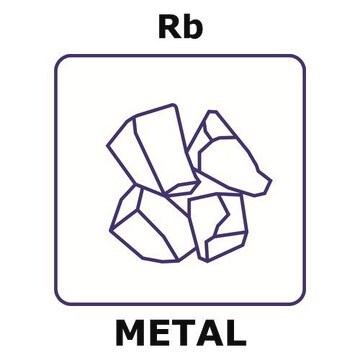About This Item
Recommended Products
Assay
99.6% trace metals basis
form
ingot
reaction suitability
reagent type: reductant
packaging
pkg of Packaged in: Breakseal Ampule
resistivity
11.0 μΩ-cm, 20°C
impurities
0.2-0.4% Cs
bp
686 °C (lit.)
mp
38-39 °C (lit.)
density
1.53 g/mL at 25 °C (lit.)
SMILES string
[Rb]
InChI
1S/Rb
InChI key
IGLNJRXAVVLDKE-UHFFFAOYSA-N
Looking for similar products? Visit Product Comparison Guide
Related Categories
General description
Application
It can also be used as a reducing agent to synthesize reduced polycyclic aromatic hydrocarbons.
Signal Word
Danger
Hazard Statements
Precautionary Statements
Hazard Classifications
Eye Dam. 1 - Skin Corr. 1B - Water-react 1
Supplementary Hazards
Storage Class Code
4.3 - Hazardous materials which set free flammable gases upon contact with water
WGK
WGK 3
Flash Point(F)
Not applicable
Flash Point(C)
Not applicable
Personal Protective Equipment
Certificates of Analysis (COA)
Search for Certificates of Analysis (COA) by entering the products Lot/Batch Number. Lot and Batch Numbers can be found on a product’s label following the words ‘Lot’ or ‘Batch’.
Already Own This Product?
Find documentation for the products that you have recently purchased in the Document Library.
Customers Also Viewed
Our team of scientists has experience in all areas of research including Life Science, Material Science, Chemical Synthesis, Chromatography, Analytical and many others.
Contact Technical Service













